SOCCHFAM 314: Child Protection Practice and Assessment
VerifiedAdded on 2022/11/18
|9
|2604
|1
Essay
AI Summary
This essay delves into the critical field of child protection, emphasizing the significance of holistic assessment practices in ensuring the well-being of children, particularly during their early years. It explores the responsibilities of practitioners in child protective services and the importance of understanding and implementing child protection procedures. The essay highlights the holistic approach, encompassing physical, relational, academic, emotional, and spiritual aspects of a child's life. It examines key practices such as resourcing, participation, comprehensive assessment, interagency communication, and early intervention, illustrating how these strategies contribute to preventing maltreatment, supporting families, and ensuring children's safety. The essay also discusses government commitments, the role of community, and the importance of data collection and analysis in improving child protection systems and policies. Furthermore, it emphasizes the need for comprehensive training and flexible procedures within the system to better safeguard children, while also addressing gender-based violence and the implementation of HIV/AIDS prevention programs.
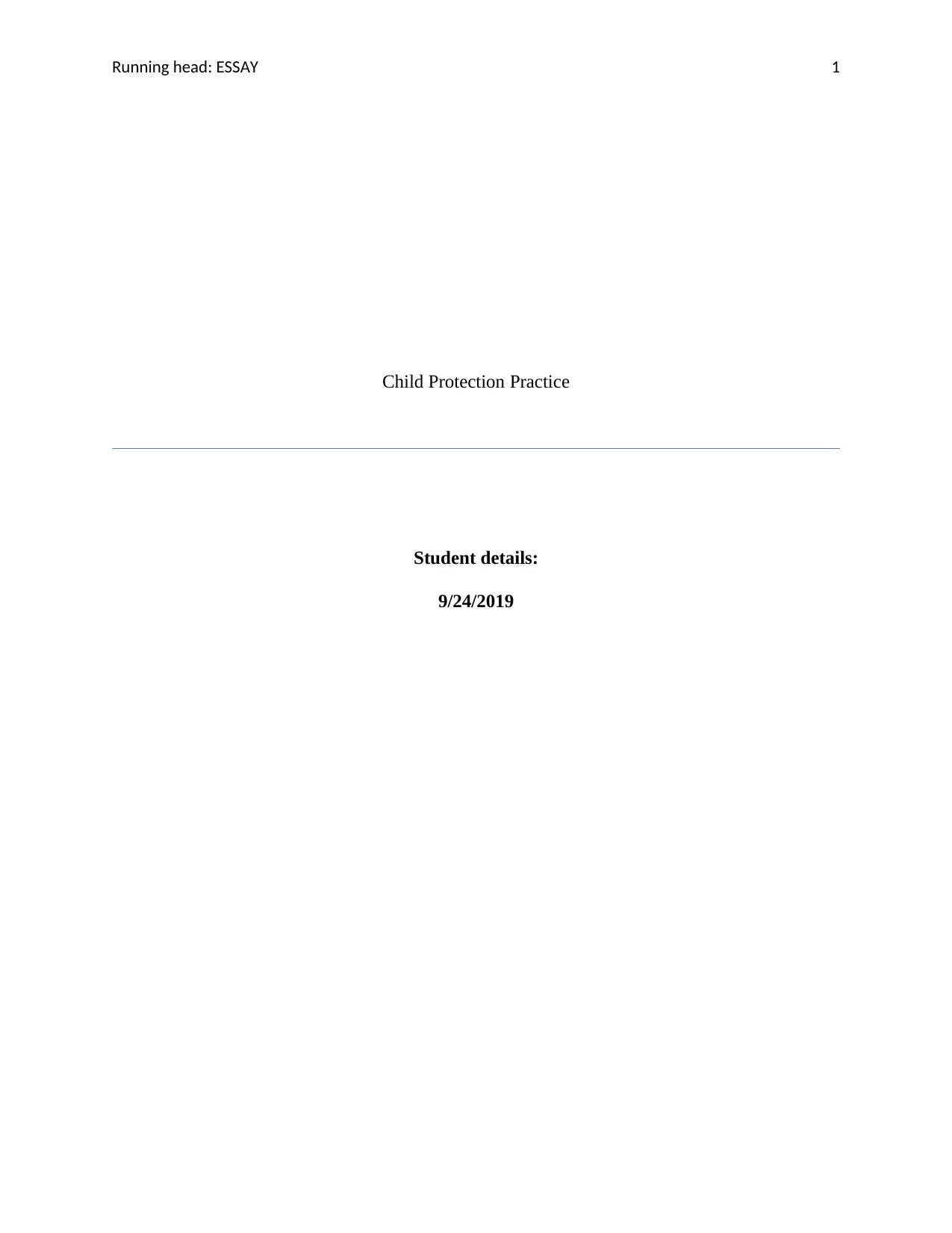
Running head: ESSAY 1
Child Protection Practice
Student details:
9/24/2019
Child Protection Practice
Student details:
9/24/2019
Paraphrase This Document
Need a fresh take? Get an instant paraphrase of this document with our AI Paraphraser
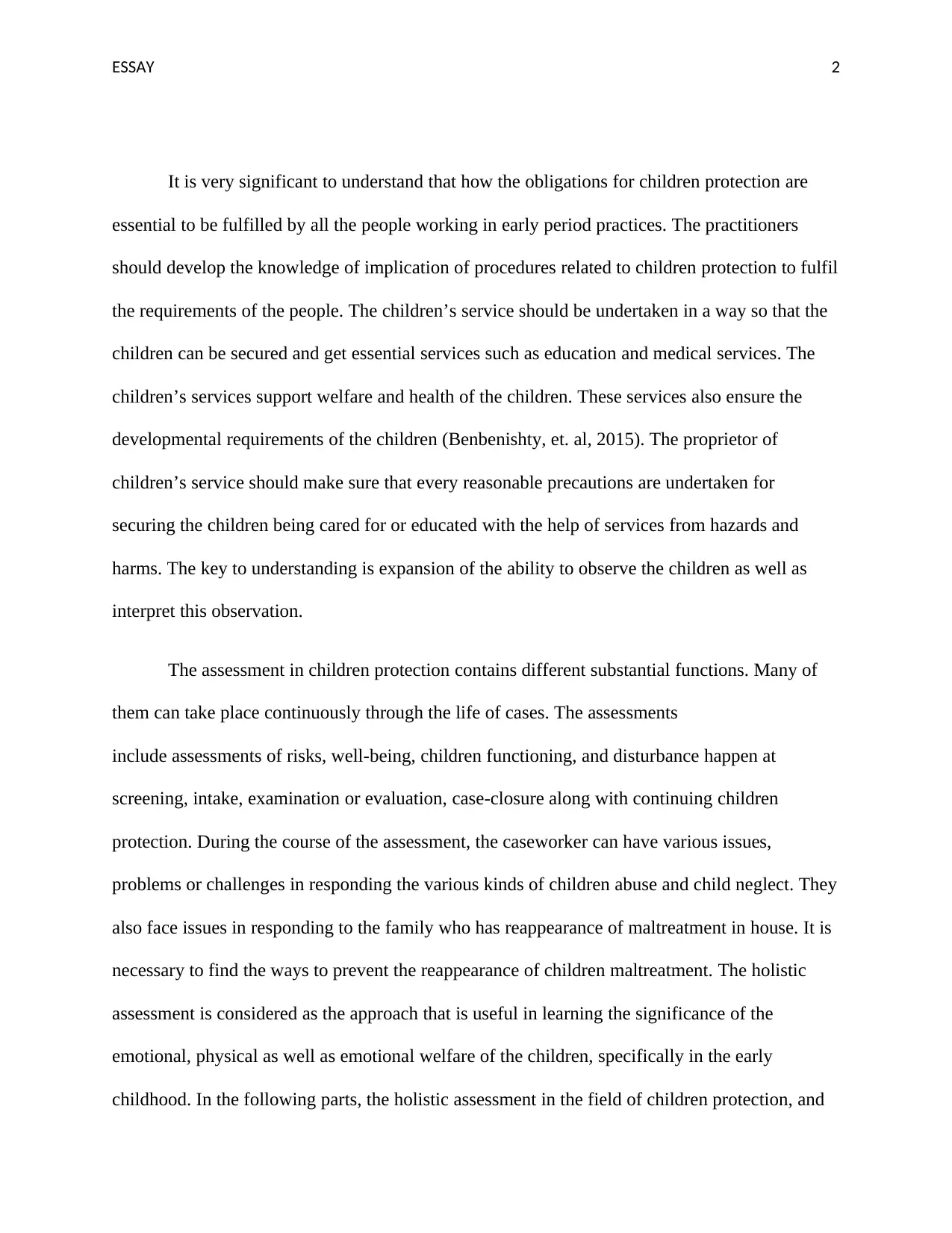
ESSAY 2
It is very significant to understand that how the obligations for children protection are
essential to be fulfilled by all the people working in early period practices. The practitioners
should develop the knowledge of implication of procedures related to children protection to fulfil
the requirements of the people. The children’s service should be undertaken in a way so that the
children can be secured and get essential services such as education and medical services. The
children’s services support welfare and health of the children. These services also ensure the
developmental requirements of the children (Benbenishty, et. al, 2015). The proprietor of
children’s service should make sure that every reasonable precautions are undertaken for
securing the children being cared for or educated with the help of services from hazards and
harms. The key to understanding is expansion of the ability to observe the children as well as
interpret this observation.
The assessment in children protection contains different substantial functions. Many of
them can take place continuously through the life of cases. The assessments
include assessments of risks, well-being, children functioning, and disturbance happen at
screening, intake, examination or evaluation, case-closure along with continuing children
protection. During the course of the assessment, the caseworker can have various issues,
problems or challenges in responding the various kinds of children abuse and child neglect. They
also face issues in responding to the family who has reappearance of maltreatment in house. It is
necessary to find the ways to prevent the reappearance of children maltreatment. The holistic
assessment is considered as the approach that is useful in learning the significance of the
emotional, physical as well as emotional welfare of the children, specifically in the early
childhood. In the following parts, the holistic assessment in the field of children protection, and
It is very significant to understand that how the obligations for children protection are
essential to be fulfilled by all the people working in early period practices. The practitioners
should develop the knowledge of implication of procedures related to children protection to fulfil
the requirements of the people. The children’s service should be undertaken in a way so that the
children can be secured and get essential services such as education and medical services. The
children’s services support welfare and health of the children. These services also ensure the
developmental requirements of the children (Benbenishty, et. al, 2015). The proprietor of
children’s service should make sure that every reasonable precautions are undertaken for
securing the children being cared for or educated with the help of services from hazards and
harms. The key to understanding is expansion of the ability to observe the children as well as
interpret this observation.
The assessment in children protection contains different substantial functions. Many of
them can take place continuously through the life of cases. The assessments
include assessments of risks, well-being, children functioning, and disturbance happen at
screening, intake, examination or evaluation, case-closure along with continuing children
protection. During the course of the assessment, the caseworker can have various issues,
problems or challenges in responding the various kinds of children abuse and child neglect. They
also face issues in responding to the family who has reappearance of maltreatment in house. It is
necessary to find the ways to prevent the reappearance of children maltreatment. The holistic
assessment is considered as the approach that is useful in learning the significance of the
emotional, physical as well as emotional welfare of the children, specifically in the early
childhood. In the following parts, the holistic assessment in the field of children protection, and
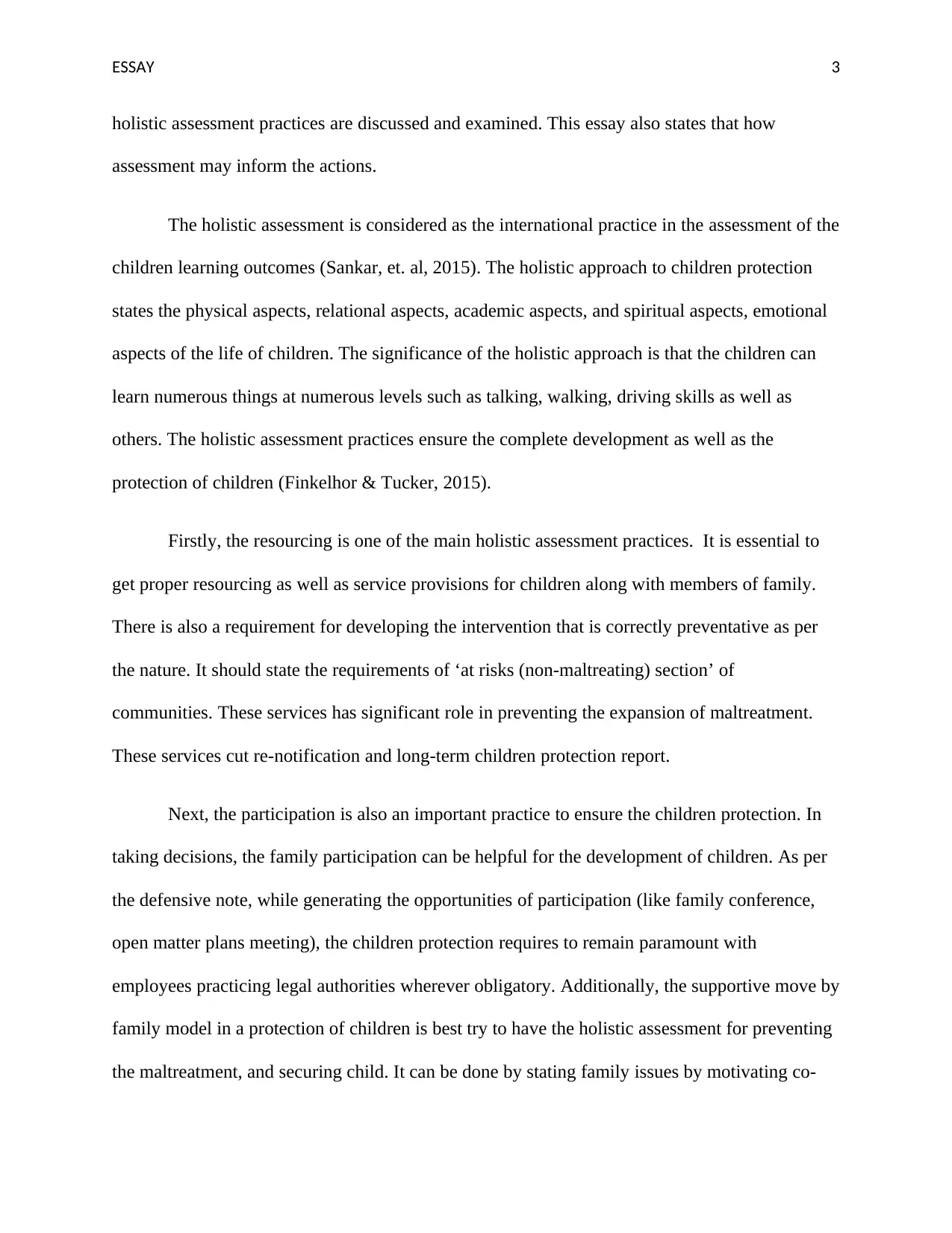
ESSAY 3
holistic assessment practices are discussed and examined. This essay also states that how
assessment may inform the actions.
The holistic assessment is considered as the international practice in the assessment of the
children learning outcomes (Sankar, et. al, 2015). The holistic approach to children protection
states the physical aspects, relational aspects, academic aspects, and spiritual aspects, emotional
aspects of the life of children. The significance of the holistic approach is that the children can
learn numerous things at numerous levels such as talking, walking, driving skills as well as
others. The holistic assessment practices ensure the complete development as well as the
protection of children (Finkelhor & Tucker, 2015).
Firstly, the resourcing is one of the main holistic assessment practices. It is essential to
get proper resourcing as well as service provisions for children along with members of family.
There is also a requirement for developing the intervention that is correctly preventative as per
the nature. It should state the requirements of ‘at risks (non-maltreating) section’ of
communities. These services has significant role in preventing the expansion of maltreatment.
These services cut re-notification and long-term children protection report.
Next, the participation is also an important practice to ensure the children protection. In
taking decisions, the family participation can be helpful for the development of children. As per
the defensive note, while generating the opportunities of participation (like family conference,
open matter plans meeting), the children protection requires to remain paramount with
employees practicing legal authorities wherever obligatory. Additionally, the supportive move by
family model in a protection of children is best try to have the holistic assessment for preventing
the maltreatment, and securing child. It can be done by stating family issues by motivating co-
holistic assessment practices are discussed and examined. This essay also states that how
assessment may inform the actions.
The holistic assessment is considered as the international practice in the assessment of the
children learning outcomes (Sankar, et. al, 2015). The holistic approach to children protection
states the physical aspects, relational aspects, academic aspects, and spiritual aspects, emotional
aspects of the life of children. The significance of the holistic approach is that the children can
learn numerous things at numerous levels such as talking, walking, driving skills as well as
others. The holistic assessment practices ensure the complete development as well as the
protection of children (Finkelhor & Tucker, 2015).
Firstly, the resourcing is one of the main holistic assessment practices. It is essential to
get proper resourcing as well as service provisions for children along with members of family.
There is also a requirement for developing the intervention that is correctly preventative as per
the nature. It should state the requirements of ‘at risks (non-maltreating) section’ of
communities. These services has significant role in preventing the expansion of maltreatment.
These services cut re-notification and long-term children protection report.
Next, the participation is also an important practice to ensure the children protection. In
taking decisions, the family participation can be helpful for the development of children. As per
the defensive note, while generating the opportunities of participation (like family conference,
open matter plans meeting), the children protection requires to remain paramount with
employees practicing legal authorities wherever obligatory. Additionally, the supportive move by
family model in a protection of children is best try to have the holistic assessment for preventing
the maltreatment, and securing child. It can be done by stating family issues by motivating co-
⊘ This is a preview!⊘
Do you want full access?
Subscribe today to unlock all pages.

Trusted by 1+ million students worldwide
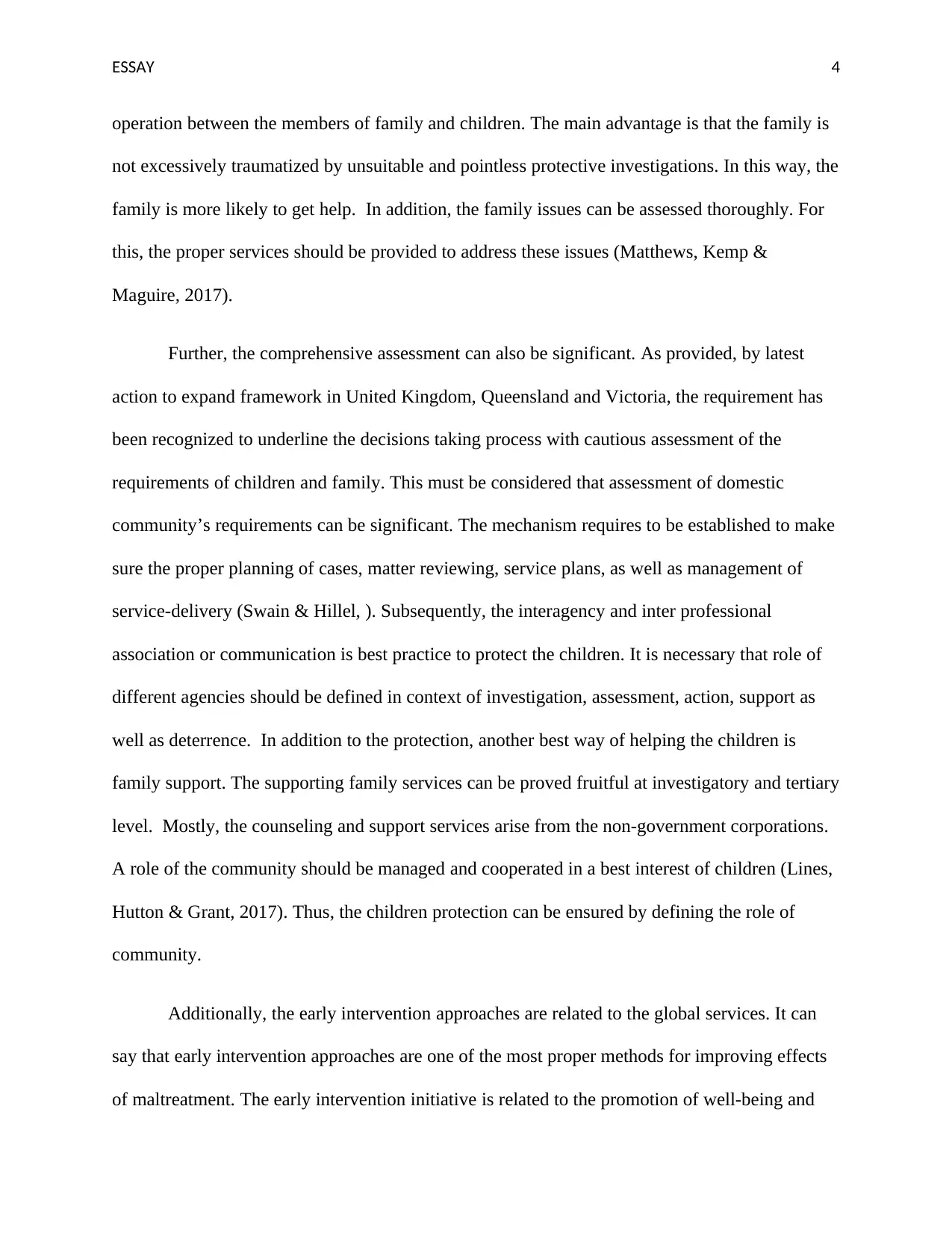
ESSAY 4
operation between the members of family and children. The main advantage is that the family is
not excessively traumatized by unsuitable and pointless protective investigations. In this way, the
family is more likely to get help. In addition, the family issues can be assessed thoroughly. For
this, the proper services should be provided to address these issues (Matthews, Kemp &
Maguire, 2017).
Further, the comprehensive assessment can also be significant. As provided, by latest
action to expand framework in United Kingdom, Queensland and Victoria, the requirement has
been recognized to underline the decisions taking process with cautious assessment of the
requirements of children and family. This must be considered that assessment of domestic
community’s requirements can be significant. The mechanism requires to be established to make
sure the proper planning of cases, matter reviewing, service plans, as well as management of
service-delivery (Swain & Hillel, ). Subsequently, the interagency and inter professional
association or communication is best practice to protect the children. It is necessary that role of
different agencies should be defined in context of investigation, assessment, action, support as
well as deterrence. In addition to the protection, another best way of helping the children is
family support. The supporting family services can be proved fruitful at investigatory and tertiary
level. Mostly, the counseling and support services arise from the non-government corporations.
A role of the community should be managed and cooperated in a best interest of children (Lines,
Hutton & Grant, 2017). Thus, the children protection can be ensured by defining the role of
community.
Additionally, the early intervention approaches are related to the global services. It can
say that early intervention approaches are one of the most proper methods for improving effects
of maltreatment. The early intervention initiative is related to the promotion of well-being and
operation between the members of family and children. The main advantage is that the family is
not excessively traumatized by unsuitable and pointless protective investigations. In this way, the
family is more likely to get help. In addition, the family issues can be assessed thoroughly. For
this, the proper services should be provided to address these issues (Matthews, Kemp &
Maguire, 2017).
Further, the comprehensive assessment can also be significant. As provided, by latest
action to expand framework in United Kingdom, Queensland and Victoria, the requirement has
been recognized to underline the decisions taking process with cautious assessment of the
requirements of children and family. This must be considered that assessment of domestic
community’s requirements can be significant. The mechanism requires to be established to make
sure the proper planning of cases, matter reviewing, service plans, as well as management of
service-delivery (Swain & Hillel, ). Subsequently, the interagency and inter professional
association or communication is best practice to protect the children. It is necessary that role of
different agencies should be defined in context of investigation, assessment, action, support as
well as deterrence. In addition to the protection, another best way of helping the children is
family support. The supporting family services can be proved fruitful at investigatory and tertiary
level. Mostly, the counseling and support services arise from the non-government corporations.
A role of the community should be managed and cooperated in a best interest of children (Lines,
Hutton & Grant, 2017). Thus, the children protection can be ensured by defining the role of
community.
Additionally, the early intervention approaches are related to the global services. It can
say that early intervention approaches are one of the most proper methods for improving effects
of maltreatment. The early intervention initiative is related to the promotion of well-being and
Paraphrase This Document
Need a fresh take? Get an instant paraphrase of this document with our AI Paraphraser
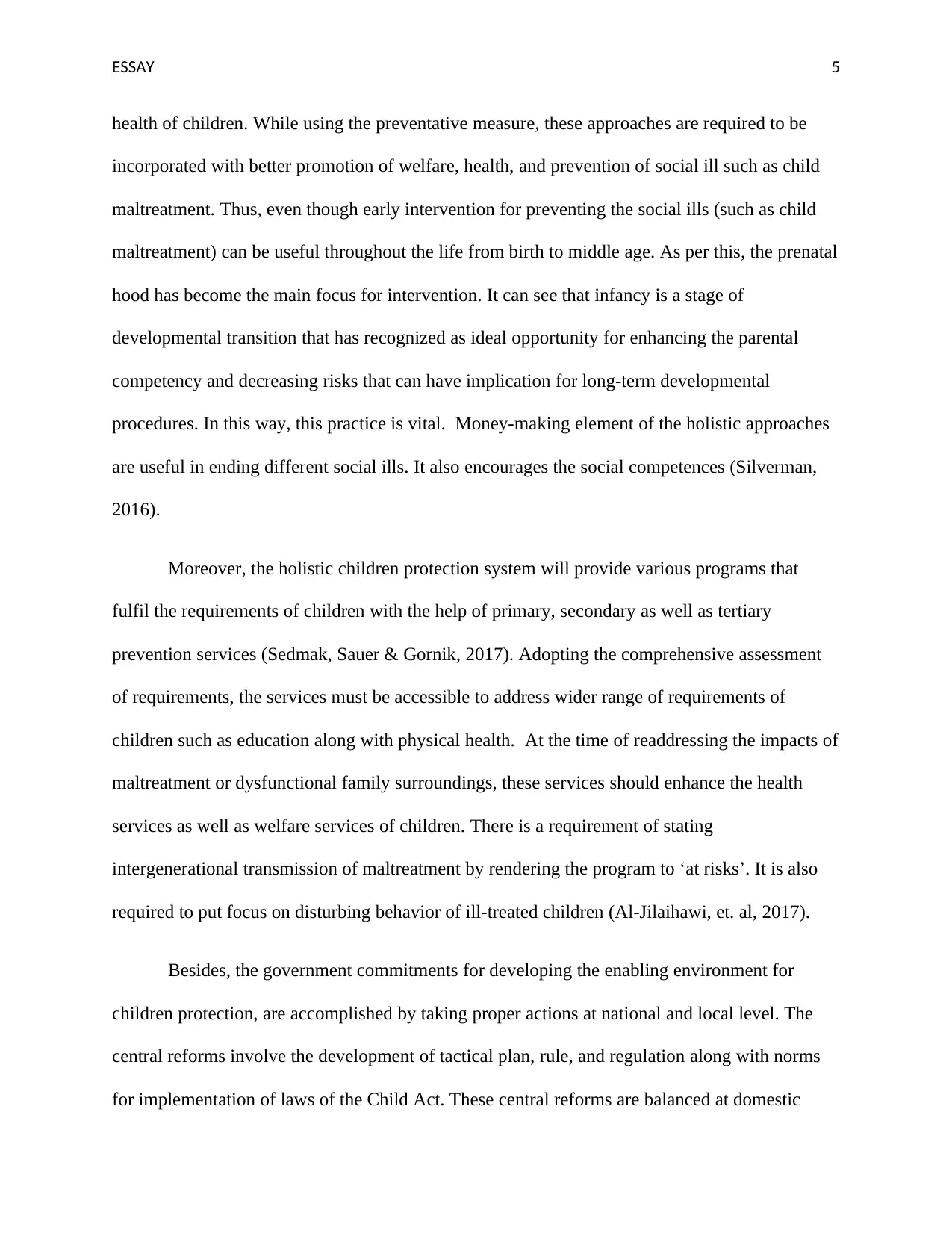
ESSAY 5
health of children. While using the preventative measure, these approaches are required to be
incorporated with better promotion of welfare, health, and prevention of social ill such as child
maltreatment. Thus, even though early intervention for preventing the social ills (such as child
maltreatment) can be useful throughout the life from birth to middle age. As per this, the prenatal
hood has become the main focus for intervention. It can see that infancy is a stage of
developmental transition that has recognized as ideal opportunity for enhancing the parental
competency and decreasing risks that can have implication for long-term developmental
procedures. In this way, this practice is vital. Money-making element of the holistic approaches
are useful in ending different social ills. It also encourages the social competences (Silverman,
2016).
Moreover, the holistic children protection system will provide various programs that
fulfil the requirements of children with the help of primary, secondary as well as tertiary
prevention services (Sedmak, Sauer & Gornik, 2017). Adopting the comprehensive assessment
of requirements, the services must be accessible to address wider range of requirements of
children such as education along with physical health. At the time of readdressing the impacts of
maltreatment or dysfunctional family surroundings, these services should enhance the health
services as well as welfare services of children. There is a requirement of stating
intergenerational transmission of maltreatment by rendering the program to ‘at risks’. It is also
required to put focus on disturbing behavior of ill-treated children (Al-Jilaihawi, et. al, 2017).
Besides, the government commitments for developing the enabling environment for
children protection, are accomplished by taking proper actions at national and local level. The
central reforms involve the development of tactical plan, rule, and regulation along with norms
for implementation of laws of the Child Act. These central reforms are balanced at domestic
health of children. While using the preventative measure, these approaches are required to be
incorporated with better promotion of welfare, health, and prevention of social ill such as child
maltreatment. Thus, even though early intervention for preventing the social ills (such as child
maltreatment) can be useful throughout the life from birth to middle age. As per this, the prenatal
hood has become the main focus for intervention. It can see that infancy is a stage of
developmental transition that has recognized as ideal opportunity for enhancing the parental
competency and decreasing risks that can have implication for long-term developmental
procedures. In this way, this practice is vital. Money-making element of the holistic approaches
are useful in ending different social ills. It also encourages the social competences (Silverman,
2016).
Moreover, the holistic children protection system will provide various programs that
fulfil the requirements of children with the help of primary, secondary as well as tertiary
prevention services (Sedmak, Sauer & Gornik, 2017). Adopting the comprehensive assessment
of requirements, the services must be accessible to address wider range of requirements of
children such as education along with physical health. At the time of readdressing the impacts of
maltreatment or dysfunctional family surroundings, these services should enhance the health
services as well as welfare services of children. There is a requirement of stating
intergenerational transmission of maltreatment by rendering the program to ‘at risks’. It is also
required to put focus on disturbing behavior of ill-treated children (Al-Jilaihawi, et. al, 2017).
Besides, the government commitments for developing the enabling environment for
children protection, are accomplished by taking proper actions at national and local level. The
central reforms involve the development of tactical plan, rule, and regulation along with norms
for implementation of laws of the Child Act. These central reforms are balanced at domestic
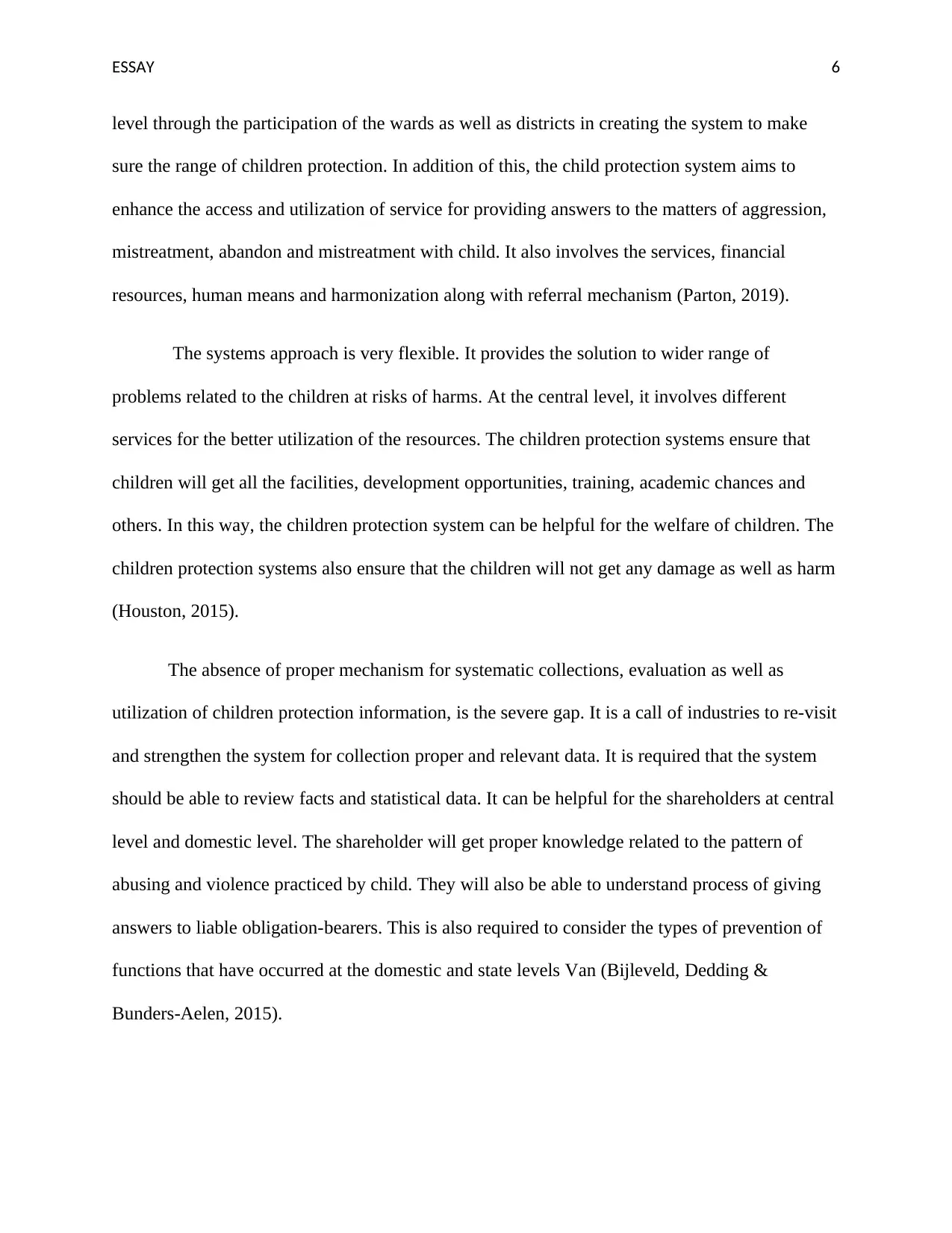
ESSAY 6
level through the participation of the wards as well as districts in creating the system to make
sure the range of children protection. In addition of this, the child protection system aims to
enhance the access and utilization of service for providing answers to the matters of aggression,
mistreatment, abandon and mistreatment with child. It also involves the services, financial
resources, human means and harmonization along with referral mechanism (Parton, 2019).
The systems approach is very flexible. It provides the solution to wider range of
problems related to the children at risks of harms. At the central level, it involves different
services for the better utilization of the resources. The children protection systems ensure that
children will get all the facilities, development opportunities, training, academic chances and
others. In this way, the children protection system can be helpful for the welfare of children. The
children protection systems also ensure that the children will not get any damage as well as harm
(Houston, 2015).
The absence of proper mechanism for systematic collections, evaluation as well as
utilization of children protection information, is the severe gap. It is a call of industries to re-visit
and strengthen the system for collection proper and relevant data. It is required that the system
should be able to review facts and statistical data. It can be helpful for the shareholders at central
level and domestic level. The shareholder will get proper knowledge related to the pattern of
abusing and violence practiced by child. They will also be able to understand process of giving
answers to liable obligation-bearers. This is also required to consider the types of prevention of
functions that have occurred at the domestic and state levels Van (Bijleveld, Dedding &
Bunders‐Aelen, 2015).
level through the participation of the wards as well as districts in creating the system to make
sure the range of children protection. In addition of this, the child protection system aims to
enhance the access and utilization of service for providing answers to the matters of aggression,
mistreatment, abandon and mistreatment with child. It also involves the services, financial
resources, human means and harmonization along with referral mechanism (Parton, 2019).
The systems approach is very flexible. It provides the solution to wider range of
problems related to the children at risks of harms. At the central level, it involves different
services for the better utilization of the resources. The children protection systems ensure that
children will get all the facilities, development opportunities, training, academic chances and
others. In this way, the children protection system can be helpful for the welfare of children. The
children protection systems also ensure that the children will not get any damage as well as harm
(Houston, 2015).
The absence of proper mechanism for systematic collections, evaluation as well as
utilization of children protection information, is the severe gap. It is a call of industries to re-visit
and strengthen the system for collection proper and relevant data. It is required that the system
should be able to review facts and statistical data. It can be helpful for the shareholders at central
level and domestic level. The shareholder will get proper knowledge related to the pattern of
abusing and violence practiced by child. They will also be able to understand process of giving
answers to liable obligation-bearers. This is also required to consider the types of prevention of
functions that have occurred at the domestic and state levels Van (Bijleveld, Dedding &
Bunders‐Aelen, 2015).
⊘ This is a preview!⊘
Do you want full access?
Subscribe today to unlock all pages.

Trusted by 1+ million students worldwide
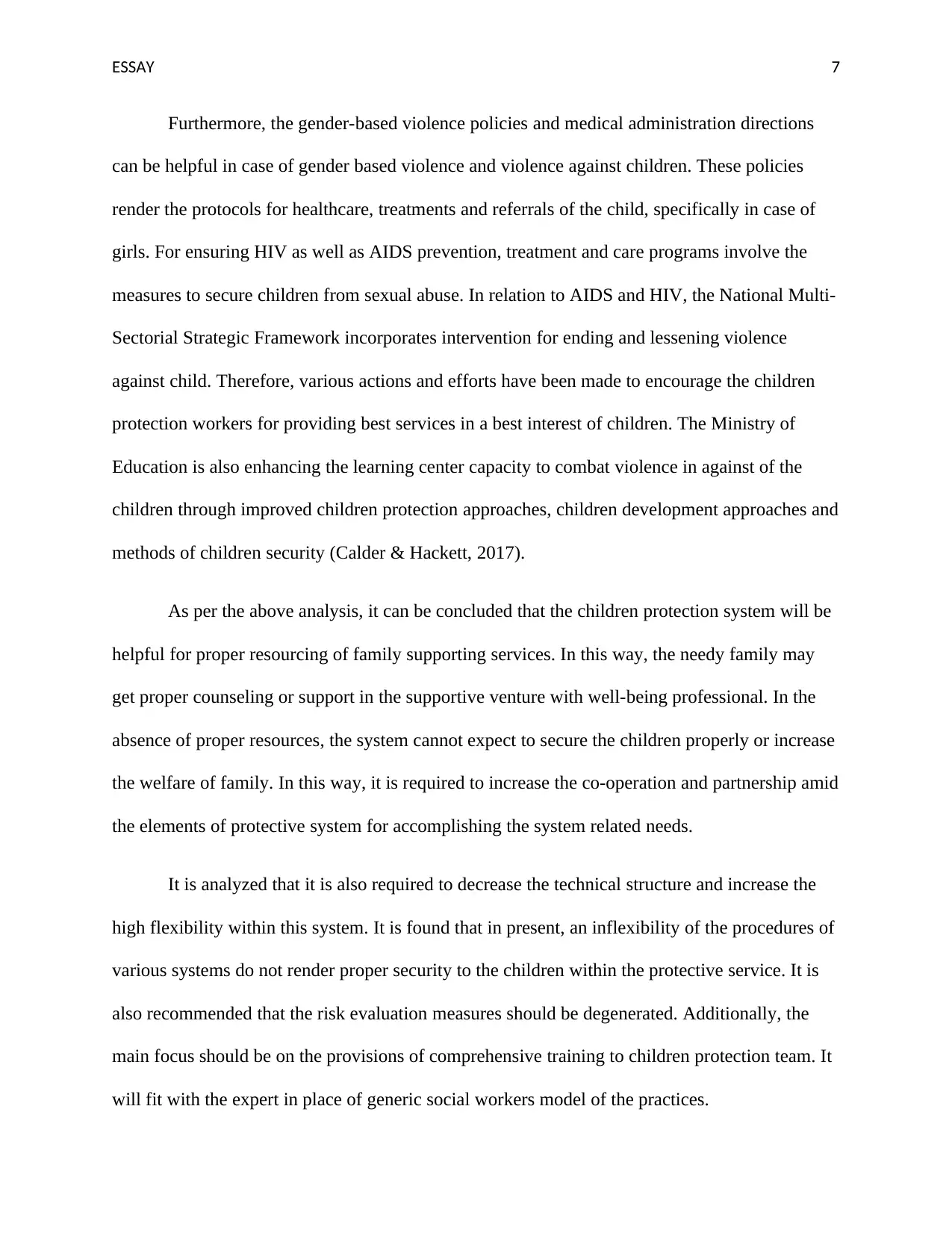
ESSAY 7
Furthermore, the gender-based violence policies and medical administration directions
can be helpful in case of gender based violence and violence against children. These policies
render the protocols for healthcare, treatments and referrals of the child, specifically in case of
girls. For ensuring HIV as well as AIDS prevention, treatment and care programs involve the
measures to secure children from sexual abuse. In relation to AIDS and HIV, the National Multi-
Sectorial Strategic Framework incorporates intervention for ending and lessening violence
against child. Therefore, various actions and efforts have been made to encourage the children
protection workers for providing best services in a best interest of children. The Ministry of
Education is also enhancing the learning center capacity to combat violence in against of the
children through improved children protection approaches, children development approaches and
methods of children security (Calder & Hackett, 2017).
As per the above analysis, it can be concluded that the children protection system will be
helpful for proper resourcing of family supporting services. In this way, the needy family may
get proper counseling or support in the supportive venture with well-being professional. In the
absence of proper resources, the system cannot expect to secure the children properly or increase
the welfare of family. In this way, it is required to increase the co-operation and partnership amid
the elements of protective system for accomplishing the system related needs.
It is analyzed that it is also required to decrease the technical structure and increase the
high flexibility within this system. It is found that in present, an inflexibility of the procedures of
various systems do not render proper security to the children within the protective service. It is
also recommended that the risk evaluation measures should be degenerated. Additionally, the
main focus should be on the provisions of comprehensive training to children protection team. It
will fit with the expert in place of generic social workers model of the practices.
Furthermore, the gender-based violence policies and medical administration directions
can be helpful in case of gender based violence and violence against children. These policies
render the protocols for healthcare, treatments and referrals of the child, specifically in case of
girls. For ensuring HIV as well as AIDS prevention, treatment and care programs involve the
measures to secure children from sexual abuse. In relation to AIDS and HIV, the National Multi-
Sectorial Strategic Framework incorporates intervention for ending and lessening violence
against child. Therefore, various actions and efforts have been made to encourage the children
protection workers for providing best services in a best interest of children. The Ministry of
Education is also enhancing the learning center capacity to combat violence in against of the
children through improved children protection approaches, children development approaches and
methods of children security (Calder & Hackett, 2017).
As per the above analysis, it can be concluded that the children protection system will be
helpful for proper resourcing of family supporting services. In this way, the needy family may
get proper counseling or support in the supportive venture with well-being professional. In the
absence of proper resources, the system cannot expect to secure the children properly or increase
the welfare of family. In this way, it is required to increase the co-operation and partnership amid
the elements of protective system for accomplishing the system related needs.
It is analyzed that it is also required to decrease the technical structure and increase the
high flexibility within this system. It is found that in present, an inflexibility of the procedures of
various systems do not render proper security to the children within the protective service. It is
also recommended that the risk evaluation measures should be degenerated. Additionally, the
main focus should be on the provisions of comprehensive training to children protection team. It
will fit with the expert in place of generic social workers model of the practices.
Paraphrase This Document
Need a fresh take? Get an instant paraphrase of this document with our AI Paraphraser
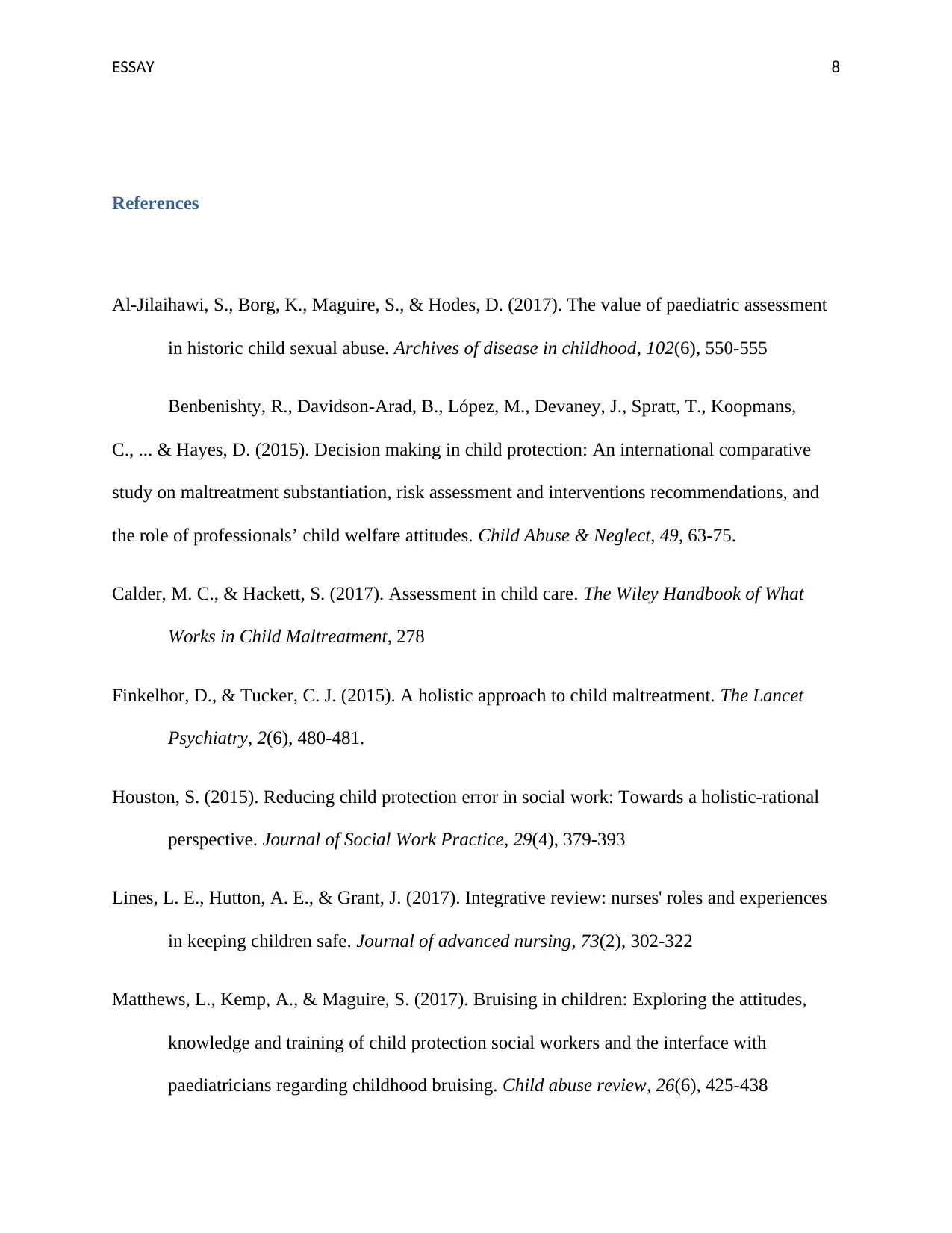
ESSAY 8
References
Al-Jilaihawi, S., Borg, K., Maguire, S., & Hodes, D. (2017). The value of paediatric assessment
in historic child sexual abuse. Archives of disease in childhood, 102(6), 550-555
Benbenishty, R., Davidson-Arad, B., López, M., Devaney, J., Spratt, T., Koopmans,
C., ... & Hayes, D. (2015). Decision making in child protection: An international comparative
study on maltreatment substantiation, risk assessment and interventions recommendations, and
the role of professionals’ child welfare attitudes. Child Abuse & Neglect, 49, 63-75.
Calder, M. C., & Hackett, S. (2017). Assessment in child care. The Wiley Handbook of What
Works in Child Maltreatment, 278
Finkelhor, D., & Tucker, C. J. (2015). A holistic approach to child maltreatment. The Lancet
Psychiatry, 2(6), 480-481.
Houston, S. (2015). Reducing child protection error in social work: Towards a holistic-rational
perspective. Journal of Social Work Practice, 29(4), 379-393
Lines, L. E., Hutton, A. E., & Grant, J. (2017). Integrative review: nurses' roles and experiences
in keeping children safe. Journal of advanced nursing, 73(2), 302-322
Matthews, L., Kemp, A., & Maguire, S. (2017). Bruising in children: Exploring the attitudes,
knowledge and training of child protection social workers and the interface with
paediatricians regarding childhood bruising. Child abuse review, 26(6), 425-438
References
Al-Jilaihawi, S., Borg, K., Maguire, S., & Hodes, D. (2017). The value of paediatric assessment
in historic child sexual abuse. Archives of disease in childhood, 102(6), 550-555
Benbenishty, R., Davidson-Arad, B., López, M., Devaney, J., Spratt, T., Koopmans,
C., ... & Hayes, D. (2015). Decision making in child protection: An international comparative
study on maltreatment substantiation, risk assessment and interventions recommendations, and
the role of professionals’ child welfare attitudes. Child Abuse & Neglect, 49, 63-75.
Calder, M. C., & Hackett, S. (2017). Assessment in child care. The Wiley Handbook of What
Works in Child Maltreatment, 278
Finkelhor, D., & Tucker, C. J. (2015). A holistic approach to child maltreatment. The Lancet
Psychiatry, 2(6), 480-481.
Houston, S. (2015). Reducing child protection error in social work: Towards a holistic-rational
perspective. Journal of Social Work Practice, 29(4), 379-393
Lines, L. E., Hutton, A. E., & Grant, J. (2017). Integrative review: nurses' roles and experiences
in keeping children safe. Journal of advanced nursing, 73(2), 302-322
Matthews, L., Kemp, A., & Maguire, S. (2017). Bruising in children: Exploring the attitudes,
knowledge and training of child protection social workers and the interface with
paediatricians regarding childhood bruising. Child abuse review, 26(6), 425-438
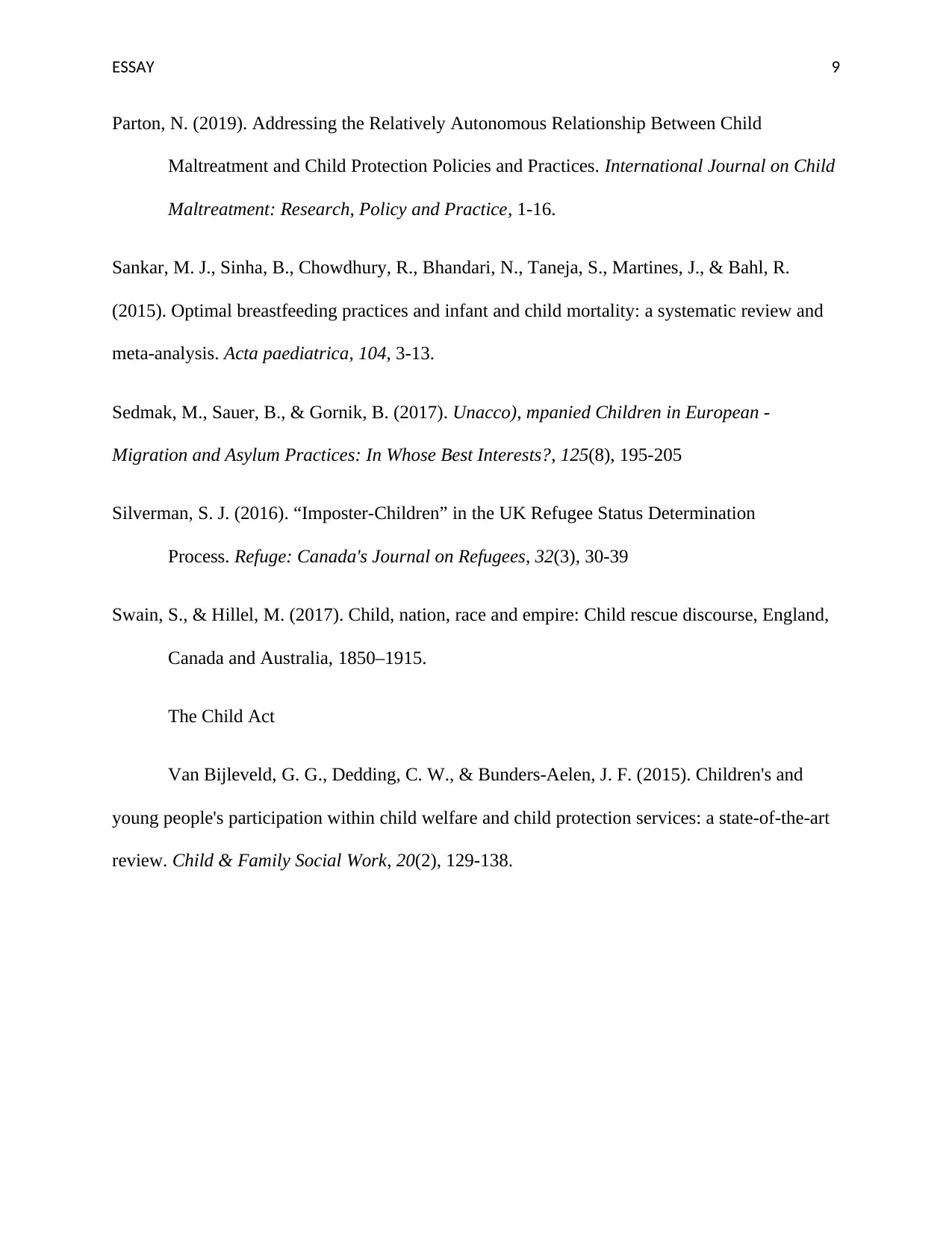
ESSAY 9
Parton, N. (2019). Addressing the Relatively Autonomous Relationship Between Child
Maltreatment and Child Protection Policies and Practices. International Journal on Child
Maltreatment: Research, Policy and Practice, 1-16.
Sankar, M. J., Sinha, B., Chowdhury, R., Bhandari, N., Taneja, S., Martines, J., & Bahl, R.
(2015). Optimal breastfeeding practices and infant and child mortality: a systematic review and
meta‐analysis. Acta paediatrica, 104, 3-13.
Sedmak, M., Sauer, B., & Gornik, B. (2017). Unacco), mpanied Children in European -
Migration and Asylum Practices: In Whose Best Interests?, 125(8), 195-205
Silverman, S. J. (2016). “Imposter-Children” in the UK Refugee Status Determination
Process. Refuge: Canada's Journal on Refugees, 32(3), 30-39
Swain, S., & Hillel, M. (2017). Child, nation, race and empire: Child rescue discourse, England,
Canada and Australia, 1850–1915.
The Child Act
Van Bijleveld, G. G., Dedding, C. W., & Bunders‐Aelen, J. F. (2015). Children's and
young people's participation within child welfare and child protection services: a state‐of‐the‐art
review. Child & Family Social Work, 20(2), 129-138.
Parton, N. (2019). Addressing the Relatively Autonomous Relationship Between Child
Maltreatment and Child Protection Policies and Practices. International Journal on Child
Maltreatment: Research, Policy and Practice, 1-16.
Sankar, M. J., Sinha, B., Chowdhury, R., Bhandari, N., Taneja, S., Martines, J., & Bahl, R.
(2015). Optimal breastfeeding practices and infant and child mortality: a systematic review and
meta‐analysis. Acta paediatrica, 104, 3-13.
Sedmak, M., Sauer, B., & Gornik, B. (2017). Unacco), mpanied Children in European -
Migration and Asylum Practices: In Whose Best Interests?, 125(8), 195-205
Silverman, S. J. (2016). “Imposter-Children” in the UK Refugee Status Determination
Process. Refuge: Canada's Journal on Refugees, 32(3), 30-39
Swain, S., & Hillel, M. (2017). Child, nation, race and empire: Child rescue discourse, England,
Canada and Australia, 1850–1915.
The Child Act
Van Bijleveld, G. G., Dedding, C. W., & Bunders‐Aelen, J. F. (2015). Children's and
young people's participation within child welfare and child protection services: a state‐of‐the‐art
review. Child & Family Social Work, 20(2), 129-138.
⊘ This is a preview!⊘
Do you want full access?
Subscribe today to unlock all pages.

Trusted by 1+ million students worldwide
1 out of 9
Related Documents
Your All-in-One AI-Powered Toolkit for Academic Success.
+13062052269
info@desklib.com
Available 24*7 on WhatsApp / Email
![[object Object]](/_next/static/media/star-bottom.7253800d.svg)
Unlock your academic potential
Copyright © 2020–2025 A2Z Services. All Rights Reserved. Developed and managed by ZUCOL.





